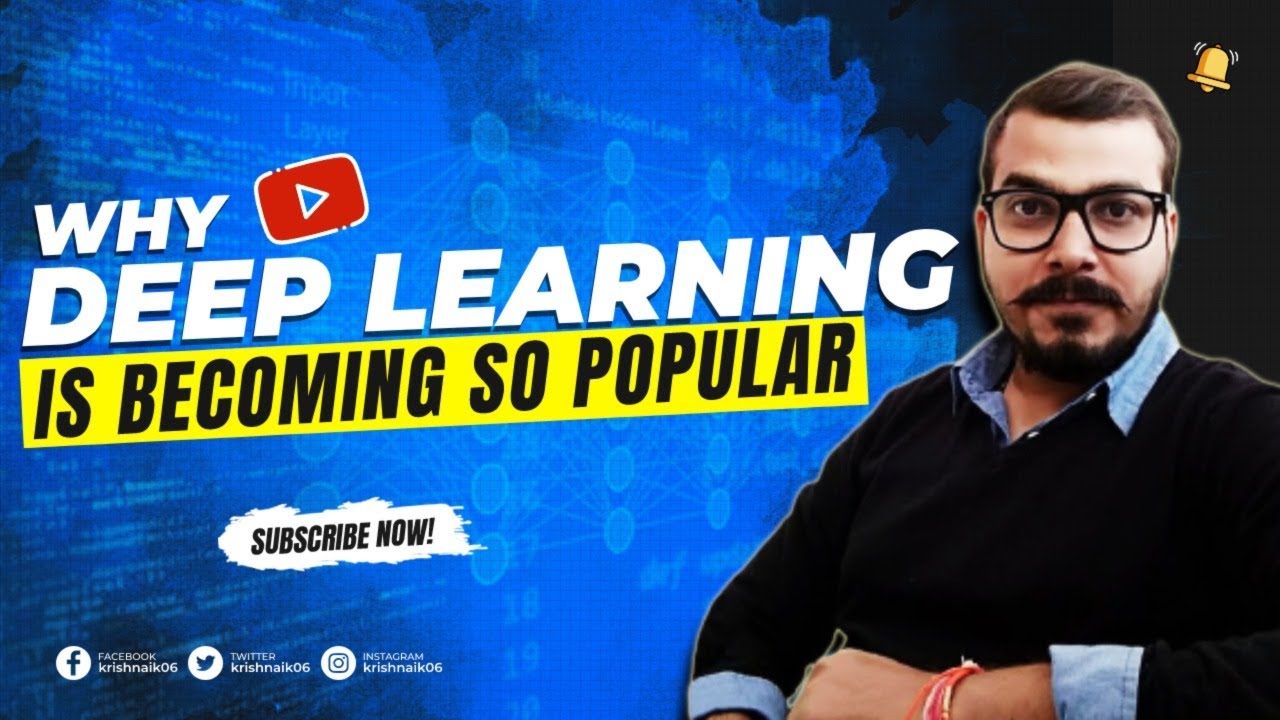Complete Road Map To Prepare For Deep Learning🔥🔥🔥🔥
Summary
TLDRIn this video, Krishna provides a complete roadmap for learning deep learning, highlighting its importance in modern data science jobs. He explains the foundational concepts like neural networks, loss functions, optimizers, and activation functions. Krishna also discusses advanced topics such as artificial neural networks (ANN), convolutional neural networks (CNN), recurrent neural networks (RNN), and transfer learning. Viewers are encouraged to practice these techniques through projects, deployments, and cloud platforms. The video emphasizes hands-on learning and provides guidance on using popular libraries like Keras, TensorFlow, and PyTorch.
Takeaways
- 😀 Deep learning is essential for data science jobs today, alongside machine learning.
- 📚 The core of deep learning includes neural networks that mimic the human brain's learning process.
- 🧠 The foundational topics include neural networks, loss functions, optimizers, and activation functions, which are essential before diving into specific models.
- 🤖 Mastering artificial neural networks (ANN) is a critical first step, followed by deployment knowledge using tools like Flask and cloud platforms.
- 🖼️ Convolutional Neural Networks (CNN) are vital for handling image and video data, with key concepts like filters, strides, and layers to understand.
- 📈 Recurrent Neural Networks (RNN) and its variants like LSTM, GRU, and attention models are crucial for sequence-based tasks like natural language processing (NLP) and time series forecasting.
- 🛠️ Libraries such as Keras, TensorFlow, PyTorch, Hugging Face, and Ktrain are important tools for implementing deep learning models.
- 📦 Deployment skills, including Dockerization and cloud services, enhance practical knowledge and project completion.
- 🔍 For image-based tasks, CNN combined with transfer learning techniques (like ResNet and Inception) is highly recommended.
- 🏆 Staying updated with state-of-the-art models like GPT-3 is important, but the focus should remain on mastering the fundamentals of ANN, CNN, and RNN for interviews.
Q & A
What is the significance of deep learning in the current job market for data science roles?
-Deep learning is becoming increasingly important in the data science job market. While machine learning was sufficient to get jobs a few years ago, many companies now seek candidates proficient in both deep learning and machine learning to meet industry demands.
Why did deep learning come into existence, and what is its primary objective?
-Deep learning was developed to mimic the human brain, allowing machines to learn in a way similar to humans. The concept of neural networks, which underpins deep learning, was introduced by researchers like Geoffrey Hinton, particularly through the backpropagation algorithm.
What foundational concepts should be understood before diving into deep learning?
-Before learning deep learning, one should understand neural networks, loss functions, optimizers (like gradient descent and Adam), and activation functions (like ReLU, tanh, and sigmoid). Mastering the math behind these concepts is essential for grasping deep learning.
What is the role of optimizers in deep learning, and why is Adam Optimizer widely used?
-Optimizers, such as gradient descent and Adam, adjust the weights of a neural network during training to minimize the loss function. Adam is popular because it adapts the learning rate dynamically, improving the speed and accuracy of training compared to other optimizers.
How can you apply the knowledge of artificial neural networks (ANN) to real-world projects?
-Once familiar with ANN, you can solve machine learning problems like regression and classification. You should also learn how to deploy ANN models using web frameworks like Flask, and deploy them on cloud platforms like AWS, Azure, or Heroku for practical applications.
What are the key differences between artificial neural networks (ANN) and convolutional neural networks (CNN)?
-While ANN is used for general machine learning tasks, CNN is specialized for processing image and video data. CNNs use additional layers like convolution layers, which apply filters to images, enabling the network to detect patterns and features in visual data.
What are some advanced topics to explore in convolutional neural networks (CNN)?
-Advanced topics include transfer learning techniques like VGG, ResNet, and Inception. For more experienced learners, object detection algorithms like RCNN, Mask RCNN, SSD, and YOLO are crucial to understand for tasks involving object recognition in images.
What are the key concepts in recurrent neural networks (RNN) and NLP applications?
-In RNNs, concepts like LSTM (Long Short-Term Memory), GRU (Gated Recurrent Units), word embeddings, and sequence-to-sequence models are critical. NLP applications often involve tasks like translation, sentiment analysis, and text generation using models like BERT and Transformers.
Why is sequence-to-sequence modeling important in NLP, and how are encoders and decoders involved?
-Sequence-to-sequence models are important for tasks where the input and output are both sequences, such as language translation. Encoders process the input sequence, while decoders generate the output sequence, often improved by using attention mechanisms for better context understanding.
What are some resources or platforms recommended for learning and practicing deep learning?
-The speaker suggests using platforms like Keras, TensorFlow, and PyTorch for deep learning implementation. Additionally, blogs and resources like Keras' documentation, Hugging Face (for NLP), and practical projects using Docker and cloud platforms like AWS are recommended.
Outlines

Этот раздел доступен только подписчикам платных тарифов. Пожалуйста, перейдите на платный тариф для доступа.
Перейти на платный тарифMindmap

Этот раздел доступен только подписчикам платных тарифов. Пожалуйста, перейдите на платный тариф для доступа.
Перейти на платный тарифKeywords

Этот раздел доступен только подписчикам платных тарифов. Пожалуйста, перейдите на платный тариф для доступа.
Перейти на платный тарифHighlights

Этот раздел доступен только подписчикам платных тарифов. Пожалуйста, перейдите на платный тариф для доступа.
Перейти на платный тарифTranscripts

Этот раздел доступен только подписчикам платных тарифов. Пожалуйста, перейдите на платный тариф для доступа.
Перейти на платный тарифПосмотреть больше похожих видео

What is Data Science? | Complete RoadMap | Simply Explained

Tutorial 23- Operation Of CNN(CNN vs ANN)

Complete Detailed Roadmap To Learn AI In 2025 With Free Videos And Resources

Why Deep Learning Is Becoming So Popular?🔥🔥🔥🔥🔥🔥

The Complete Data Science Roadmap (Get Hired in 2025)

Tutorial 1- Anaconda Installation and Python Basics
5.0 / 5 (0 votes)
